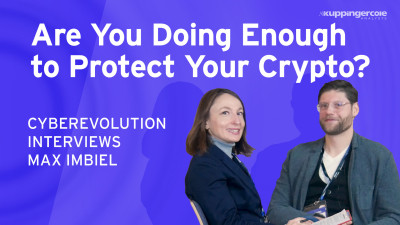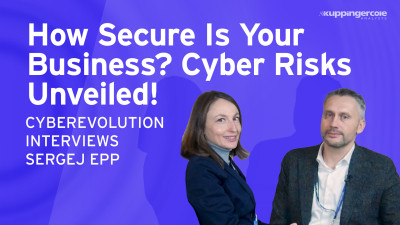The last keynote this morning is also from a vendor, also looking at the cloud and our entities, but I think putting it a little bit in a larger context and to bring all the different ends together that we have seen in the last three days, please welcome Luca Martin and C patas. Good morning.
Good morning.
So yo with Oracle, right? So can you give us very short information about your role at Oracle?
So you're, I think you're identity management expert. Are you a security guy? Is that
Right? Kind of right. So I'm part of the development group. I joined Oracle 2001, actually it's my ninth cooking event this year. Okay. And I'm the local representative of the identity access management development organization here in Europe, middle east and Africa. I'm not only looking after IBM, also parts of fusion, middleware, and IOT. Okay.
And on my side, I take care of identity and access management too, from a business development perspective, especially related to the digital theme.
So, which is really the topic today, actually to understand the role of identity into the digital transformation that we are, you know, facing, seeing, and sometimes is contributing to, to happen actually.
Okay. So you actually trying to do what I said, putting it in larger context, the floor is
Yours.
Thank you, Sasha.
Fantastic. So our story today has three parts. One we would like to give you an overview. What are the four fundamental trends or later as we call them forces in the area of identity access management second, and this is the part that Luca will put emphasis on digital. And the topic of today was evolution or revolution. And in this conference we heard a lot, the word digital transformation, which kind of stands for revolution, but we hardly heard the term digital disruption, which is kind of more a revolution.
So we're gonna seek out what this term digital disruption means and how identity plays a major role in digital disruption. And then we are gonna show two customer videos, how two customer of our successfully implemented a digital strategy in their enterprise.
But before we start, we would like to take you on a journey. We would like to explain, first of all, why the universe exists and humbly speaking, we need to leave a little idea away out of this equation. And what are we gonna explain?
Here are the four fundamental forces of physics that are out there, out there and might have created the universe force. Number one, gravitation while we all know that the universe is expanding. Gravitation is the counterforce that pulls things together. Like the earth is rotating amongst the sun, which is caused by the force of gravity. But also another example is the apple falling from the tree on the earth, given gravitation as explained by Newton. It's also very easy to explain.
If you think about stepping on a trampoline with your mass and you're carving an inclination, the tissue of the trampoline, and now roll a ball in the trampoline.
It will curve amongst the mass. The more you wait, the more you incline or the more you curve, the trampoline, the faster this ball will get to you, which is also something that is caused by gravitation. So this is the first force. The second is electromagnetism. And to keep it really simple, it's a mixture of electricity and magnetism.
And even more simple, if electrons are moving, we see this force, perhaps that was a little too simply explained, but if electrons are emotion, they also create a magnetic field. So you see this force everywhere. You see it in light in lightning, you even see without this force, there would be no engines, no network, no it, and hence also no identity management. So a very important force to bring to the table.
Now we're getting smaller, very tiny, and really a fraction of what we can see.
We're going inside the nucleus of an atom and in the nucleus of an atom, you have protons and neutrons and you know what? Protons are positively charged. And we all learned in physics that if something is positively charged, it should repel. It should not attract each other, but still there is a force, a very strong force, which keeps the atoms together. And this is what we call the strong nuclear force. And we know how it's one of the, it is the strongest force. And we unfortunately know how strong this force is in an atomic explosion where Irans nuclears are turned apart.
And this is the energy. Well also radiation Gama rates are also, which are not very healthy, brought, brought to air, but this is the force that is behind this, the strong nuclear force.
And the last one is the weak nuclear force. And this is very hard to explain, but a good example is what happens in the sun, where you have hydrogen reacting to Helio 5, 4, 4 hydrogen, a homes reacting to helium. But in addition, also radiation which comes to earth, which gives warmth. We see the sun shining and lets the earth flourish. Why am I pitching this? There are two very important things to this.
Every force has its reasons of existence. Without gravitation, there would be no stars, no planets, nothing that could pull the energy together. This is very important without electromagnet meant the strong nuclear force. If though suddenly would disappear.
Now, while I speak, I would be vanishing or better, I would just simply dissolve the second thing. What is also very important is physicists have not found this out yet. And Einstein also during his last days of living, he tried to find this grand unified theory that explains all the other four forces.
It's not yet found this theory of everything. And now we're gonna make the analogy to the topic today and see if we have found in the topic today, this theory of everything. So let's have a quick look at the four. I'm gonna call it.
Now the fundamental forces of identity, access management trends, the analogy trends that we do see in the market. Number one, mobile, and this trend or four started about four or five years ago with people bringing their own devices in the enterprise. And it suddenly losing control people with their personal devices were doing emails, were doing corporate files and it wanted to gain that control back MDM mobile device management was the first iteration to deal with that force, but it just restricted the phone.
So what also came to the picture is a way how to restrict not only to restrict the phone, but also to differentiate what is business related and what is personal.
This is what we call mobile application management. But this is strong is a lot bigger because this is not only about mobile security. Mobility also means having a framework in place, how you can develop mobile apps, deploying those mobile apps on Android and iOS. It also means this is also very important integration.
So yes, you can build your cool apps, but at one point of time to really add value to your business, you need to integrate your systems, especially in a B2B use case. So this is not only about mobile security here. The picture is bigger. The second is social. And I would like to share an anecdote with you about social, how we as Oracle, mispositioned the value of social.
Once this came up, we're having customer advisory boards where we show customer functionality early, before the functionality gets out to the market and social, we showed to the customer around about five years ago, but we just showed the integration or the authentication via Facebook and Google.
And you know what customer told us, this is great, but in a B2B sense, we don't need it. We will never trust Facebook and Google. We fully mispositioned the value of this force. This is about loosely couple integration.
If your customers are on Google or Facebook, you want a loosely couple integration to your Porwal. You want to know what those customers are doing, and if they want to consume more services, you still have the possibility of a sec. Second factor authentication, great force, and also great use case that we'll share later on how this force was beautifully used cloud cloud. There's two parts to that. First of all, enabling the cloud, a simple example, you all know the Oracle cloud, the Oracle cloud is also powered power, IDM, Oracle, and IDM being an enabler of the Oracle cloud.
The second use case is putting IDM functionality in the cloud.
So not deploying any more IDM on premise, having this deployment done in a multi-tenant fashion in the cloud and the last forces that I'm very happy to see that in this conference, we talked a lot about it. It's internet of things, great use cases that we see out in the market, connected vehicles. We showed a use case actually last year at the European identity conference at smart metering, we're gonna show a use case later. It's already there.
Now coming back to the analogy that we had with the universe and before forces, something is also fundamentally important here. First point is we call it extension. Think about it this way. Single sign on you already have delivered. Onpram. Now the force of mobile comes. You also want to deliver single sign on, on mobile. You want to deliver single sign on, on cloud. You should not be replicating functions.
You should be in a position to simply extend what you already have on premise to the new forces or whatever comes next. It's not only about feature and functions extension.
It's also about the rule set. So you already defined your rule, set your policies on premise. You want to leverage this mobile. You want to leverage this for social. You want to leverage this for the cloud. This is what we're heavily investing from an Oracle perspective, this extension, because the world, it will be hybrid. You will never be throwing everything away that you have on premise and then move to the cloud. And one point of time you guys need to extend. And the second I wanna lead to Lucas's topic, but it's a mixture mixing, extending, and mixing, mixing.
This forces will bring you to something that we call digital disruption. And by all means we as Oracle, we're also mixing this forces, mobiles, all, all these forces are already available.
Mobile and social is already mixed are really thought about perhaps putting it as one force, but also what will come in the future cloud and IOT in summer, we're gonna bring to the market an IOT cloud service in autumn, a mobile cloud service until the end of the year 16 cloud service, just in the area of middleware, what we call platform as a service.
So also we as a vendor heavily are looking into mixing these fundamental forces and why are we doing this? The reason behind it's evolution or revolution, but also to enable you as a customer to go to this notion of digital disruption. And I will like to ask Luca to tell us what is about,
Thank you, Kristin. So very pleased to be here. My side first time for me here, actually. And I feel like to be in the right place to talk, not just about identity management, but actually, which is the role of identity management into the digital transformation.
I think that five years ago, our job as an identity professional was really to find out that spot into all the projects or try to convince someone that identity was key part of, you know, the next business initiative. Now it's the other way around. In many cases, hopefully they are reaching us asking, you know, why we don't have identity enabled applications sometimes, but it's again important to understand why and which is the role of identity into the digital transformation disruption to do that. I will do a step in, I will do three steps actually with you.
I like to was more journey taking a look to the past.
So everything started, you know, put yourself 10, 10 years ago, 15 years ago, you were maybe downloading. I was downloading maybe, I don't know, some MP3s through peer-to-peer networking, publishing that anonymously on some networking, you know, website to have someone else who have that access to what is happening now to the record industry. Bottom line, you had apple coming in, for example, allowing people to download, you know, in a legal way and to buy also the songs.
And today you have services like Spotify, which is actually allowing you as your identity, social connected via your mobile to listen to the music you want. You can share it if you want with your friends. And you're receiving suggestion based based of that, we are into this kind of disruption actually today. And we as a consumer, as an end user, we are actually facing the same situation with, with other kind of business, think about the web publishing.
So we are receiving content that we like digitally subscription based.
For example, think about the disruption that happened to the postal service we are using it. We are part of the digital transformation and disruption. It's really changing the business model. Things are done at the customer. It's went through the email and now we are talking about, you know, how to secure this kind of stuff more and more think about the photo and Kodak, for example, what happened to Kodak just a couple of years ago because of the digital innovation and disruption.
So you are taking pictures with your phone based on the GPS location, for example, and you're sharing it, you're keeping it, you're archiving it. And maybe using that in that, in some here. And that's really identity related.
Again, don't want to spend too much time on that, but it's moving to the money real stuff.
So think about the new digital money, which is upcoming in all this kind of situation, which are coming from the past is not just today. Identity is the key thread actually, which is driving new services to, to, to the community and to the end user. So let's continue our small journey and let's have a look to the future.
Actually, this is already happening, but I want to talk to your story about pros. This is an American company it's into the medical sector, let's say, and they are doing researches and drug testing, actually drug trials. They had the approval last year to commercialize these pills, actually these ingestible pills, which is activated into your stomach because of organic activators and allowing them to collect information from your body as being part of this, you know, medical trial activity.
And it's communicating with a patch with containing a sensor, which is on your skin, or if you want into your skin.
But few of them are actually going with that. And that's, that's, that's that's patch is talking to mobile device, which is collecting the information and sending them directly to S or customer of, for analyzing the information and providing suggestions about how to exactly manage the doses of the medicine you have to take, especially for, you know, this kind of research they are doing actually a new medicine actually. Is it identity related?
Yes, for sure. Is it identity fundamental from day zero, maybe from that day main minus one in the initiative for sure. And that's why for example, Oracle decided to invest from a stock perspective. So we are stock owner of this company for a small amount of money because this is actually the digital disruption, which is bringing to the digital medicine. So another kind of innovation is at the future more or less, but it's also happening today.
We thought about, you know, many, many kind of Christian was talking about social thing, social, enabling, you know, communication and identification.
There is another interesting trend which is happening now in Europe, in European union, actually, which is I call it the digital identity provider of economy. I, I, I bring in one, just one example, which is coming from UK. So the government of UK put together an interesting project, which is objective, is to allow you as a citizen, as a consumer, as a digital identity to access the government services through your trusted identity provider could be your bank could be your post office, could be your total company. You can select he's your trusted identity provider. Is it social login?
No, it's not. It's different, but it's really done by the European commission, not just by the government of UK to enable the digital market, to enable the digital transformation actually into the market.
So we as identity management professional are really part of this kind of transformation. And by the way, this is not just happening in Europe. This is happening in United States. There is a pilot right now running on this kind of initiative.
And by the way, there are also active initiative in France and in Italy because of these eiders regulation, which is coming up in Europe, which is exactly having the objective of having me like former students of the university of bologna, to be able to subscribe, for example, to an executive MBA of the university of Munich, just with my university of bologna identity. Is it business related for sure? Is it simplifying, connecting things absolutely.
And, and processes. Yes. Is it happening because of there is the identity enabler for that? So that's our part, that's our job today, actually I think into the, into the, into the, you know, transformation business of, of identity, the big problem, sometimes I think in, in, in our organization when we are having talks, you know, with the businesses to explain sometimes and to remind, which is the strategic role of identity in this area.
And the second question usually is, but is there a digital identity or digital architecture, you know, sorry, is there an architecture for digital identity?
And the answer for sure is no, because it's something which is continuously evolving and really depending on the specific case. But I think that we could at light, at least three things, first of all, there is one big topic which is changing the identity world, which is the relationship between people and devices.
By now the identity management project are usually very focused on identity, but we have to put them together from now, if we want to enable, you know, the adoption of devices and the adoption of the IOT, actually, secondly, you know, there is the possibility for us to enable rapid deployment of the applications, providing secure services through, for example, API services. That's actually allowing people to develop fast application, reusing what they already have in a secure way.
And in a, let's say identity aware way.
Then there is the data actually consumer identity is the reason for which the marketing organization is doing many new business initiatives. What do we have to do about that?
Yes, we have to take care about the data, the data in transit from the device, from the IOT device, for example, to my API. And at the same time, also the data that we store 76%, according to the Verizon of the data breaches are happening because parcel have been stolen. We are still having that issue. So with that kind of blocker, are we going to go to the next step? So we really need to have this kind of conversation.
And this is actually something that I'm having, not just with the CIO sometimes also with the C the chief digital officer, the, the chief risk officer, new kind of figures, which are helping us in this way.
And sometimes, you know, I have to remind that since business is really driven thing, driven driving things, which is the, you know, money behind the digital security market. This is not the money that, you know, the security company are making.
This is the black market about digital, you know, crime somehow, as you can see, is really higher than, you know, for example, the cocaine market or whatever it is. So that, that's a big reason that we, I think we have to share within our company, to, to our peers and those guys to remind how much security in the digital economy is really making that trust, which is needed to have the next step and continue to have success on that business initiative with your customer actually.
So I'm, I'm just, you know, referring here to Warren Buffett, which said, trust is like the air we breathe. Actually, you feel that you don't have hair when you're just missing it. So I'm using this light, usually for opening a conversation with chief marketing officer. But I think it's something that we could use to internally with, with our conversation, with a customer. I would like to end over to Christian, cuz we would like to talk to you about a couple of customers stories.
So,
And Saha has already on stage. I know we extended too much space time continuum. I'm gonna skip one customer present one customer pitch, but allow me just to show one about how electr bell, what digital means for electr bell. So I'm gonna skip SafeNet, we're gonna show it on the booth, but very happy to show electr bell. So first of all, it's about a multi omnichannel experience, but it's also combination of the forces of it's
Check
Out my voice
Smart energy box from electro bell electric AB the smart energy box.
Slimer
So a great example of combination of internet, of things, mobile and social with that. I'm done.
Thank you, Sasha.
Thank you so much. So what have you done at safe
At Safeway? Also a very cool story because Safeway, they only know the customer when they leave the store when they're paying. Yep. And the idea is why shouldn't I know the customer beforehand, why shouldn't I personalize the experience, how the customer buys, why shouldn't I also give him a way to, well, know what he previously did purchase and what he perhaps might want to purchase. And also very, very cool because they also include pricing of, of the competition.
So other attributes to personalize the shopping experience of each individual of each identity. And
You can see this at the booth, as you mentioned. Thank again. Thank
You.
Thank you.
Thank you.




















































